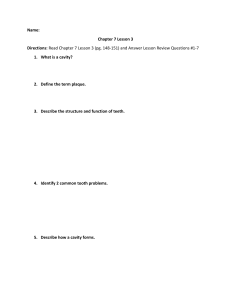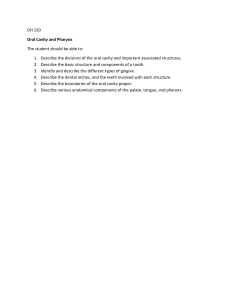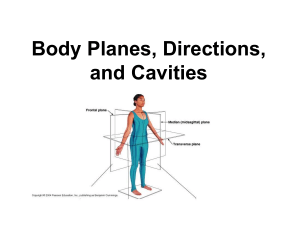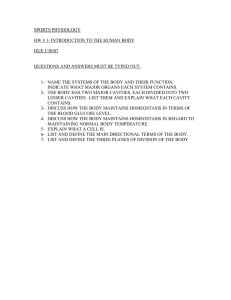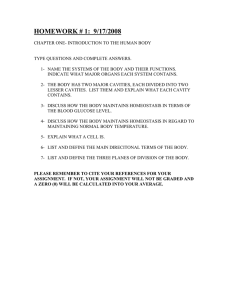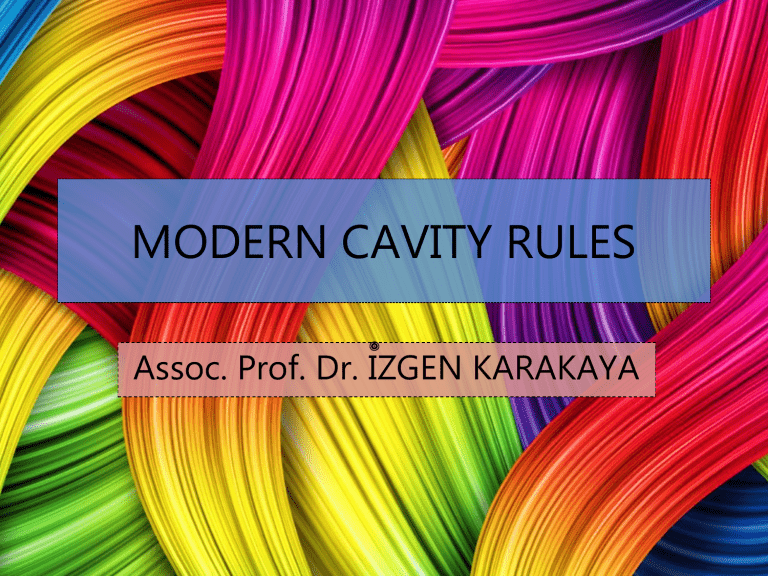
MODERN CAVITY RULES Assoc. Prof. Dr. IZGEN KARAKAYA The main purposes to treat pathologies are eliminating diseases and preventing progression and also providing the function again. The Factors affecting the cavity shape • Charactheristics of tooth structures • Properties of restorative materials • Factors related with patients • Charactheristics of carious and noncarious lesions Properties of Restorative Materials The type of the restorative material like amalgam, composite resin, GIC, seramic etc. is one of the important factors affecting the cavity shape. Properties of Restorative Materials Cavities for amalgam restorations: • The width of the cavity should provide resistance. • The cavity walls should be parallel to each other and the restoration should be in a contact with the tooth wall with 90° angle. • If the angle is less than 90°, it can cause fractures both at enamel and amalgam restoration. Properties of Restorative Materials Cavities for amalgam restorations: • To provide a mechanical retantion, the cavity floor should be wider than the outer borders of the cavity. • The depth of the cavity should be enough for the appropriate condensation of the amalgam. Properties of Restorative Materials Cavities for composite resin restorations: • The cavity walls can be prepared more rounded and the sound tissue can be saved. • Beveling can be made at enamel except the occlusal areas where the direction of the enamel prisms are appropriate for an effective etching. Factors Related with the patients • Oral hygiene and the risk for caries are affecting the desicion of treatment methods. • First all of the patients should be motivated about oral hygiene. Although this; if the patient’s oral hygiene is not well (especially at geriatric patients and mental retarded patients), amalgam and GIC should be prefered for restorations and the cavity walls should be ended at areas that can be cleaned well by brushing to prevent seconder carieses. • Fissure sealents can be used for the patients with a high risk for caries formation. Charactheristics of tooth structures • As the enamel is the hardest tissue of the body, there can be fractures easily so for all the cavity types it’s important to be sure that all the enamel walls are supported by dentin. • Tooth with highly tissue loss can be treated by pin and post treatments according to the flexible structure of dentin. Charactheristics of tooth structures The shape and the location of the pulp is another important factor affecting the cavity shape. Charactheristics of tooth structures For deep caries lesions to save the pulp vitality, it is important to know the morphology of the pulp and to make radiologic examination before begining the treatment. Charactheristics of carious and noncarious lesions • The traditional treatment methods for caious lesions were explained by G.V. Black. • Traditional treatment suggests to remove all of the demineralized dentin and unsupported enamel, to prepare enough space for the restorative material, to make an appropriate cavity shape to provide mechanical retantion and to include all of the pit and fissures where caries can develop in the future . Charactheristics of carious and noncarious lesions • If there is no degredation of the integrity of tooth tissues at white spot lesions of caries, remineralization of the lesion is prefered instead of restorations. • If there are porosities that can cause adhesion of the plaque, the retantion areas can be abraded by burs or rubbers and than remineralization methods can be used. Charactheristics of carious and noncarious lesions If there is a highly degredation of the tooth structure to gain the function again, traditional or modern cavity preparations can be prefered according to both the sizes of the lesion and the type of the restorative material. Charactheristics of carious and noncarious lesions According to the find outs about the demineralization-remineralization cycle and developments about adhesive systems and restorative materials, modern cavities and minimal invasive dentistry started to take an important place at clinics. By the minimal invasive dentistry the difference between the infected and affected dentin gained importance to save the pulp vitality. Modern Cavities for Proximal Caries Lesions • Microchip • Minibox • Box-only • Slot • Tunnel Microchip Proximal Cavity If there is a degradation of the integrity at marginal areas by small porosities, microchip cavities can be prepared with a limited extention at occlusal and proximal areas. Minibox Proximal Cavity If the caries is wider, minibox cavities can be prepared same shaped as microchip cavities with a wider form. BOX-ONLY Cavity • Caries at the proximal area of the posteriors (Not too wide) • No caries at occlusal • Healthy periodontal tissue • Ideal occlusion BOX-ONLY • Amalgam BOX-ONLY • Composite Resin BOX-ONLY Bonded Amalgam • To increase the retantion of the amalgam especially for the tooth with unsufficient occlusogingival height and restorations with pins, amalgam bonding agents were developed. While using these agents, cavity walls should be rounded for enough wettability of the agent to the cavity walls. • Amalgambond was the first developed agent. Slot Cavity • At the proximal carieses where there is no adjacent tooth or at the root carieses where it is easy to reach without removing the marginal area slot cavities can be prefered. Slot Cavity • It has an eliptical shape with parallel occlusal and gingival walls which are perpendicular to cavity floor. • For the slot cavities prepared at the contact area (where the next tooth is missing), composite resin restorations can be prefered for the restoration. • If there is the next tooth and the caries is at root, smallest round burs are used to reach the caries from vestibul or lingual/palatinal areas. Beveling can be made to enamel walls and open sandwich technique is prefered for restoration. Tunnel Cavity • While reaching the proximal caries lesion, to protect marginal ridge and contact area with next tooth, tunnel cavities can be prefered. The entrance is made at mesial/distal triangular fossa without removing the marginal area. The thickness of marginal ridge should be at least 2 mm. Otherwise marginal area will be fractured. Tunnel Cavity • According to the fracture risk while condensating amalgam, it is not prefered as restoration of these cavities. • It is not possible to see directly the whole cavity so it is prefered to use GIC or open sandwich technique (GIC+Composite Resin) for the restoration. • By open sandwich technique it is possible to make more esthetic and more resistant restorations. Tunnel Cavity Sandwich Technique: If two or more materials are used for restoration, it is called sandwich technique. • Open Sandwich: All the materials are in contact with oral fluids. • Closed Sandwich: Only one of the materials is contact with oral fluids. Tunnel Cavity Advantages of GIC : • GIC, adhering both tooth structures and composite resins. • GIC, containing fluor which increase resistant against caries. • GIC, prevents microleakage better than composite resin at walls which does not include enamel. Special Cavities • By protecting oblique ridge at maxillary first molars and transverse ridge at mandibular first premolars, caries of central fossa can be removed in a more conservative way. Special Cavities • If there is caries at palatinal pit or proximal areas, cavity can be expanded to these areas by protecting the oblique ridge. The special cavities with proximal area are called modified CL2 cavities . Ref: Modern Operative Dentistry Ref: Modern Operative Dentistry • Maxillary first molar (O+OP) • Mandibulary first molar (OB) CLASS VI • The cavities prepared at the tubercules of posterior teeth especially at atrision lesions or rampant carieses.
